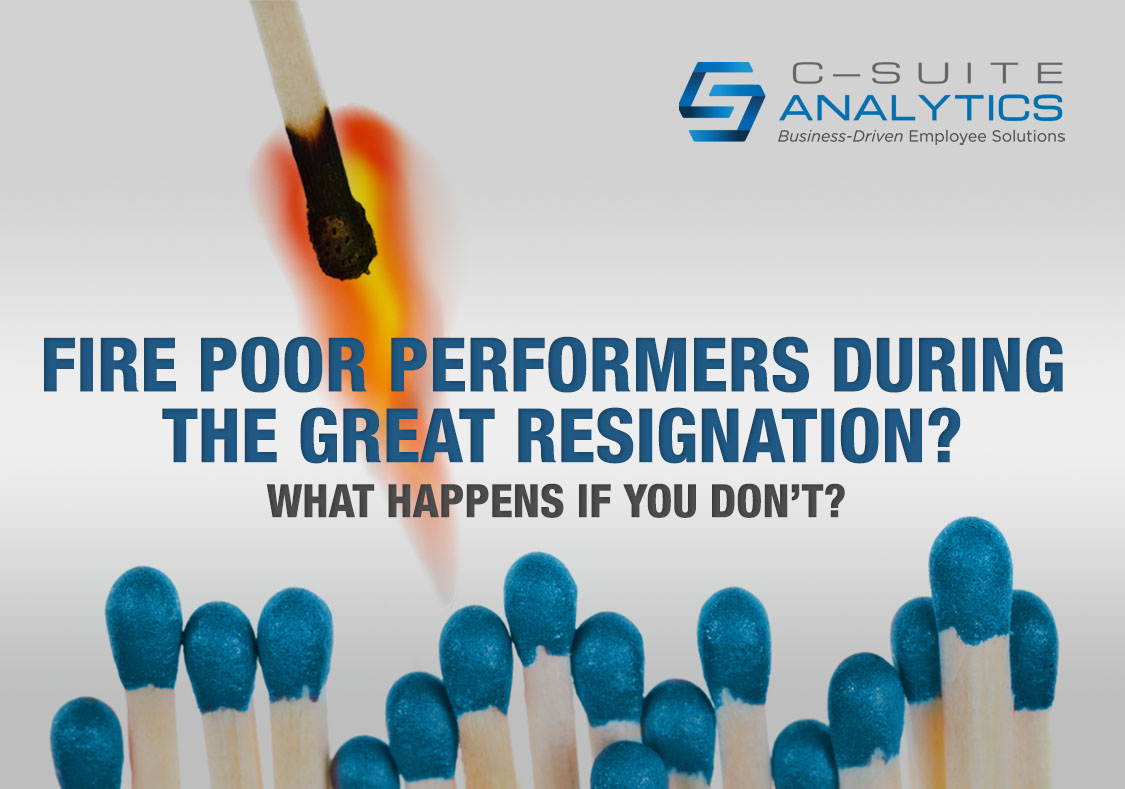Most hiring tools answer whether candidates can and will do the job, but not if they’ll stay. Learn how realistic job previews and motivational-fit interviews can improve retention from day one.
Dilemma: Fire Poor Performers During The Great Resignation?

Last year one-third of U.S. workers walked away from their jobs…and there is no sign this rage of quitting will abate during this decade. But another frightening metric is how few workers got fired.
The Bureau of Labor Statistics tells us that in December less than 1% of U.S. workers were either “discharged”…their term for fired…or laid off. The precise percentage was .08%, the lowest ever recorded.[i] The BLS doesn’t separate discharges and layoffs, but it seems hard to fathom that 99% of all workers were doing their jobs adequately and deserved to keep them. Plus, our own experiences as customers tell us so. Speaking as just one consumer, I can readily see that employees in restaurants, stores, and other service locations are on average just not as skilled, interested, nor dedicated as they used to be.
It makes sense, right? Long ago when employers had the upper hand, think 2019, managers were more willing to hold employees accountable because they had more confidence they could easily replace them. So in these times when jobs stay open for months longer and candidates are hit-and-miss, why not muscle your way along and keep the substandard performer even longer? The person you hire 90 days later might be worse.
So it’s time for all of us to ask if this syndrome is happening in our companies. Are we giving slow performers a pass because our open jobs list is so long that we don’t want to make it longer?
You would think this line comes next, that your worst employee is still your company’s #1 face to your customers. And this is true. But the far bigger consequence for holding onto substandard workers is you frustrate your top performers…and therefore place yourself at risk to lose them.
Multiple studies disclose that top performers out-perform average performers by 4 to 1. Just one of many academic studies across several industries found that the top 5% of the workforce produced 26% of the participating companies’ total output.[ii] This means literally that your top performers are producing the required work for their own jobs plus the jobs of four other employees. You are paying them one salary to do the work of five people.
These are also the employees who lead others by their hard-work example and more. Top performers are the ones others look up to want to be like and become the designated or non-designated leaders of your teams. Companies that are fighting to grow their businesses during these times of worker shortages, high inflation, and supply chain issues must retain their best workers to please their customers.
I’ve talked here before about how no employee survey can tell you as much as knowing what your employees talk about over dinner. It’s the aggregation of those end-of-workday feelings built up over weeks/months/years that drive your employees to thrive in their jobs…to look forward to doing what you pay them to do. Or to grow bitter and then tap their company-provided keyboards to take one of the currently available 10 million-plus open jobs.
We can’t know what your employees talk about over dinner, but we do know the topics. Bosses/colleagues/daily job duties are what your employee talk about over dinner. And the “colleagues” part is important because they are either smiling when describing working with someone they like or telling a frustrating tale about one of your substandard employees who constantly disappoints them and makes their jobs harder…all while chomping on their broccoli.
The bottom line is retaining low performers will cause you to lose top performers…and leave you with a workforce comprised of low performers and others who just don’t care.
The major step to holding employees accountable during “The Great Resignation” is to reduce employee turnover and thereby have fewer open jobs…and we’ve proven you CAN do it.
And these additional steps will help:
- Keep hiring standards high, even when managers just want a body.
- Ensure new hires get the skill training they deserve to succeed.
- Hold managers who retain poor performers accountable and call them out, so they improve or remove them.
Remember the risk for letting poor performers slide: You will ultimately be left with a workforce comprised of low performers and others who just don’t care.
Are your strategies for retaining employees working? If not, reach out to me to schedule a free consultation at DFinnegan@C-SuiteAnalytics.com and I will share what has worked for companies just like yours to cut turnover by 30% and more even during “The Great Resignation” and discuss how you can apply these solutions to your retention plan.
[i][i] https://www.bls.gov/news.release/jolts.htm, table 5
[ii] https://www.ere.net/top-performers-produce-4x-more-output-and-higher-quality-referrals/#:~:text=The%20top%2Dperforming%205%20percent,worker%20in%20the%20same%20job.



